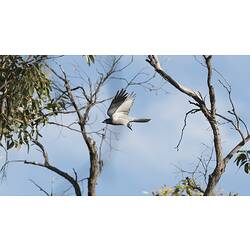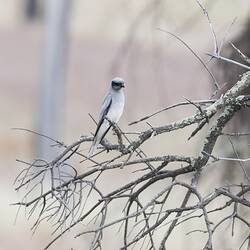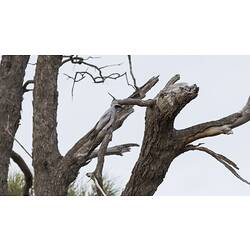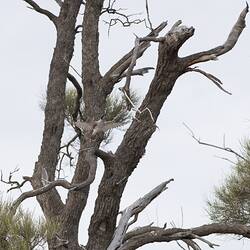General Description
A black face and throat, blue-grey wings, back and tail, and white underparts. Juveniles resemble adults, but the black is reduced to an eye stripe. Juveniles look very similar to White-bellied Cuckoo-shrikes, Coracina papuensis, which also have a black eye stripe but are a lot smaller. Head to tail length of up to 35 cm.
Biology
Black-faced Cuckoo-shrikes are neither shrikes nor cuckoos, but get their name from having a similar bill shape as the shrikes, while their feathers resemble the pattern of cuckoo feathers. They can form large flocks of up to a hundred birds during the non-breeding season. They often pair with the same partner each year, even using the same breeding territory. Considering their size, their nest is quite small and is bound together with spider webs. Black-faced Cuckoo-shrikes eat insects and other invertebrates, which they catch on the ground or in flight. They also eat seeds and fruits. The birds are partially nomadic, moving in response to the seasons. They are often seen perched on power lines. After landing they typically shuffle their wings.
Distribution
New Guinea and the Solomon Islands, Mainland Australia, Tasmania.
Habitat
Woodlands, forests, scrublands and urban areas.
More Information
-
Animal Type
-
Animal SubType
-
Brief Id
A slender bird with a prominent black face.
-
Colours
Black, Grey
-
Maximum Size
35 cm
-
Habitats
-
Diet
Omnivore
-
Diet Categories
Seeds, Fruit, Insects
-
Endemicity
-
Commercial
No
-
Conservation Statuses
CITES: Not listed, FFG Threatened List: Not listed, EPBC Act 1999: Not listed, IUCN Red List: Least Concern
-
Taxon Name
-
Common Name
Black-faced Cuckoo-shrike
-
Kingdom
-
Phylum
-
Subphylum
-
Class
-
Order
-
Family
-
Genus
-
Species Name
novaehollandiae






